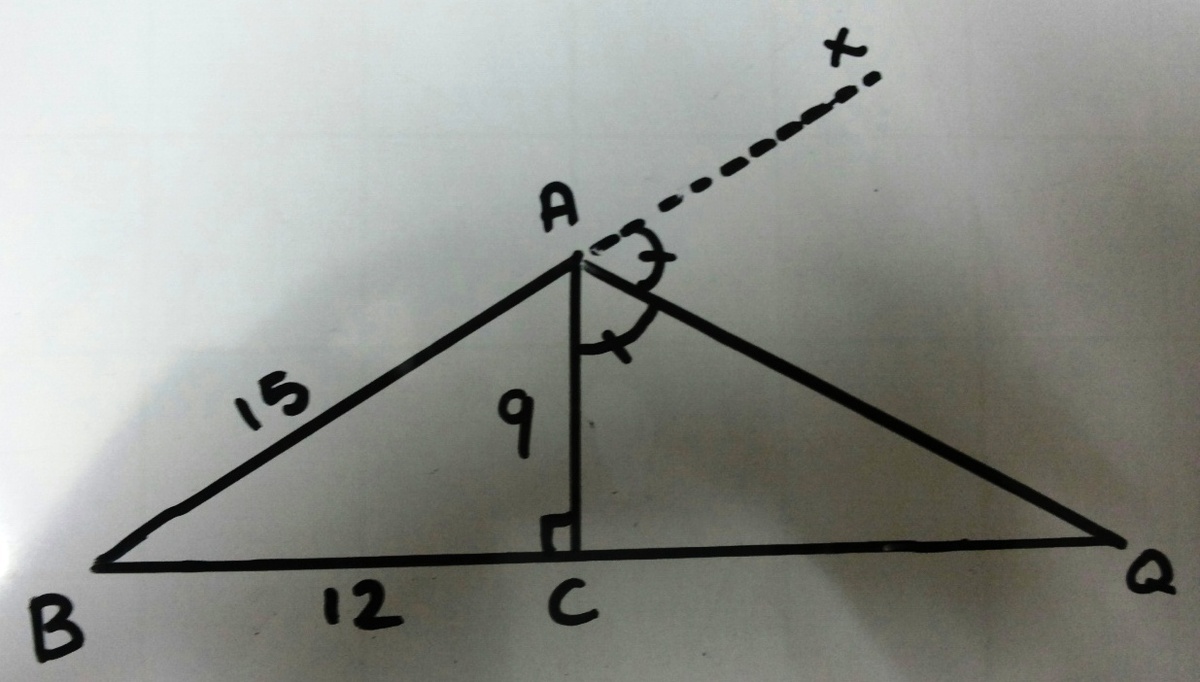Only for Geometry diehards
In △ A B Q , X is a point on B A produced. Let C be a point on B Q such that A Q bisects ∠ X A C . If B C = 1 2 , A C = 9 and A B = 1 5 , find the value of C Q + B Q .
The answer is 48.
This section requires Javascript.
You are seeing this because something didn't load right. We suggest you, (a) try
refreshing the page, (b) enabling javascript if it is disabled on your browser and,
finally, (c)
loading the
non-javascript version of this page
. We're sorry about the hassle.
3 solutions
Let X be on B A produced such that A C = A X and connect X Q . We are given that A C = 9 , B C = 1 2 and A B = 1 5 . By Pythagoras' Theorem, since 9 2 + 1 2 2 = 1 5 2 , △ A B C is a right-angled triangle with ∠ A C B = 9 0 ∘ . Now, since it is given that A Q bisects ∠ X A C , let ∠ C A Q = ∠ X A Q = x . Then ∠ B A C = 1 8 0 − 2 x and ∠ A B C = 2 x − 9 0 . Since A C = A X , ∠ C A Q = ∠ X A Q and A Q is a common side, △ C A Q is congruent to △ X A Q , implying that ∠ A X Q = ∠ A C Q = 9 0 ∘ and ∠ C Q X = 2 × ∠ A Q C = 1 8 0 − 2 x . We observe that △ A B C is similar to △ Q B X , implying that B Q : X Q is in the ratio 1 5 : 9 . Since C Q = X Q , C Q = 1 8 and C Q + B Q = 4 8 .
The figure will be somewhat like this,

ABC is a right angeled triangle,
∴ t a n ( A B C ) = B C A C = 1 2 9 = 4 3 = 0 . 7 5
⟹ ∠ A B C = t a n − 1 ( 0 . 7 5 ) = 3 6 . 8 6 9 9
Now, by exterior angle property,
∠ X A C = ∠ A B C + ∠ A C B = 3 6 . 8 6 9 9 + 9 0 = 1 2 6 . 8 6 9 9
⇒ ∠ C A Q = 2 1 ∠ X A C = 6 3 . 4 3 4 9
Again, triangle ACQ is a right angled triangle,
∴ t a n ( C A Q ) = t a n ( 6 3 . 4 3 4 9 ) = A C C Q = 9 C Q
⟹ C Q = 2 × 9 = 1 8
∴ C Q + B Q = 1 8 + 1 8 + 1 2 = 4 8
Since the sides of triangle ACB are given to be 12, 9 and 15, it can be deduced that triangle ACB is a right angle triangle since 12, 9 and 15 form a Pythagorean triplet.
ϕ= arcsin(12/15).
2θ+ϕ= 180°.
So θ= [(180-ϕ)/2]° = [(180-arcsin(12/15)/2]° = arctan(2).
So CQ/9= 2, implying that CQ= 18.
Thus, CQ+BQ= 18+(18+12)= 48.